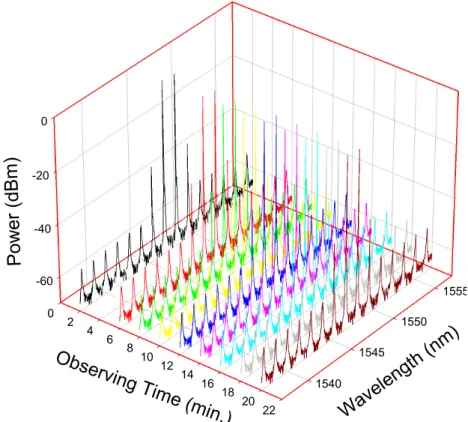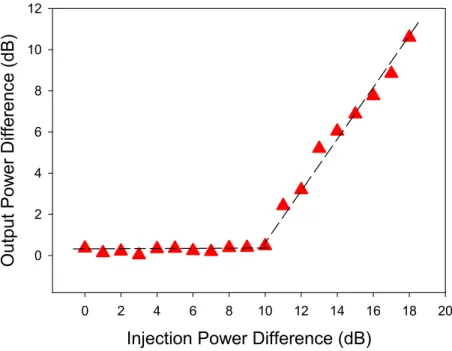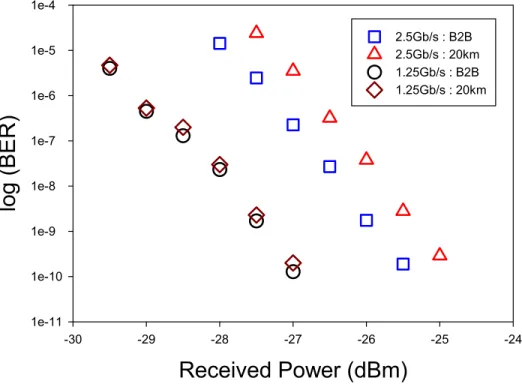Two-Mode Semiconductor Laser for mm-Wave in Radio over Fiber
Transmission
C. H. Yeh
a, C. W. Chow
b, Y. F. Wu
*b, F. Y. Shih
b, C. H. Wang
b, and S. Chi
ba
Information and Communications Research Laboratories, Industrial Technology Research Institute
(ITRI), Taiwan;
b
Department of Photonics and Institute of Electro-Optical Engineering, National Chiao Tung
University, Taiwan
ABSTRACT
In this investigation, an mm-wave RoF transmission link with dual beat-mode optical source is investigated. We demonstrate a 170 GHz band millimeter-wave source using an external dual-mode-locked Fabry-Perot laser diode (FP-LD) with a 1.38 nm mode-spacing. Two distributed feedback (DFB) lasers are used to inject the corresponding modes of FP-LD to generate dual-beat-mode output. The proposed dual-mode laser is not only stable, but also has single-longitudinal-mode (SLM) output characteristics. Moreover, we also investigate the relationship between two external-injected wavelengths for the dual-wavelength output.
Keywords: external-injection; mm-wave; Fabry-Perot laser diode
1. INTRODUCTION
Recently, optical mm-wave techniques are considered to serve as one of the promising methods for wireless communications due to the ability to carry high data rate signal for broadband access networks [1]. It is also considered as a replacement for the high-definition (HD) and 3D video cables in the near future [2]. Generally, using optical modulator to produce the dual-wavelength by optical carrier suppression method could generate an mm-wave based on mode beating in fiber communication [3]. Besides, the dual-wavelength also could be generated by using Sagnac loop, high-birefringence fiber loop mirror, or nonlinear soliton designs according to erbium-doped and ytterbium-doped fiber based ring cavity to obtain dual-wavelength output [4]-[10]. However, due to the longer fiber ring cavity in these laser schemes, it would result in the unstable and multi-longitudinal-frequency (not single-longitudinal-mode) output performances comparing with our proposed mm-wave laser configuration.
In this measurement, the dual beat-mode FP-LD can be directly modulated at 1.25 Gb/s and 2.5 Gb/s, respectively, using the NRZ pseudo random binary sequence (PRBS) with pattern length of 231-1. At the Rx end, a high speed PD could be used to convert the optical data to RF data at the carry frequency of 170 GHz (generated by the heterodyne beating at the PD), and then emitted by the antenna (ANT). In this proof-of-concept demonstration, due to the unavailable of a high-speed PD at the laboratory, a PD with low-pass 2.5 GHz bandwidth (Bessel third order) was used to detect the RF signal. To realize the mm-wave over fiber performance, the bit error rate (BER) measurements are performed. Fig. 5 shows the BER curves at 1.25 and 2.5 Gb/s NRZ direct modulations under B2B and 20 km long transmission distances, respectively. The received power sensitivities at BER of 10-9 are -27.5 and -26 dBm under 1.25 and 2.5 Gb/s, respectively, as shown in Fig. 5. Besides, the inserts of Fig. 5 are the measured corresponding eye diagrams. It is noted that dual-mode travels in the fiber and would cause the differential propagation delay due to fiber chromatic dispersion [11]. We observed a small power penalties of 0.2 and 0.5 dB power penalties at the BER of 10-9 are observed under 1.25 and 2.5 Gb/s respectively, after through 20 km long single-mode fiber (SMF). Besides, the dual beat-mode laser using optical injection with coherence performance by autocorrelation measurement has also been performed in the past [12].
*yves.wu@livemail.tw
Optical Transmission Systems, Switching, and Subsystems VIII, edited by Yikai Su, Ernesto Ciaramella, Xiang Liu, Naoya Wada, Proc. of SPIE-OSA-IEEE Asia Communications and Photonics, SPIE Vol. 7988,
798824 · © 2011 SPIE-OSA-IEEE · CCC code: 0277-786X/11/$18 · doi: 10.1117/12.888538 SPIE-OSA-IEEE/ Vol. 7988 798824-1
2. EXPERIMENT AND RESULTS
The optical mm-wave signal can be generated by our proposed laser scheme based on two-mode injection technology, as shown in Fig. 1. The dual-mode laser generator is consisted of two distributed feedback laser diodes (DFB-LDs), two polarization controllers (PCs), a 1×2 optical coupler (CP), a 3-ports optical circulator (OC) and a Fabry-Perot laser diode (FP-LD). In this experiment, the bias current of FP-LD is operated at 30 mA at the temperature of 23 oC. To obtain dual-wavelength output from the FP-LD, two distributed feedback laser diodes (DFB1 and DFB2) are used to act as the external injection lights to inject two corresponding longitudinal modes. And the two PCs are employed to adjust the properly injecting polarization status to retrieve the two beat wavelengths to generate optical mm-wave. Fig. 2 presents the originally output spectrum of FP-LD with a 1.38 nm mode spacing (Δλ) before external injection. And, Fig. 2 also shows the output dual beat-mode spectrum of the proposed laser source before directly modulating the FP-LD when two DFB-LDs are used to inject into FP-LD with two corresponding modes. The obtained dual-beat-wavelengths are at 1545.34 and 1546.72 nm with the peak power of -4.9 and -4.6 dBm, as seen in Fig. 2. Besides, the insert of Fig. 2 shows the output spectra of the dual beat-mode while the beating signal without and with direct modulation of the FP-LD with a non-return to zero (NRZ) format data at 1.25 and 2.5 Gb/s, respectively. Fig. 2 also shows the side-mode suppression ratio (SMSR) of 34 dB for the proposed dual beating-mode laser scheme.
DFB
1
DFB
2
1.25/2.5 Gbps
Fig. 1. Experimental setup of proposed dual-wavelength laser generator.
Next, we will study the output stabilities of dual-wavelength and powers for the proposed laser scheme. Thus, a short-term observation of the output powers and wavelengths was measured, as shown in Fig. 3. The lasing two wavelengths were at 1545.34 and 1546.72 nm (λ1 and λ2) with initially and the observation time was over 20 minutes. In Fig. 3, the wavelength variations of λ1 and λ2 for the proposed mm-wave laser can dramatically keep to zero over the observation of 20 minutes. And the two power fluctuations of the two lasing modes are obtained within 0.05 dB. After four hours observation time, the stabilized output of the proposed mm-wave laser is still maintained.
SPIE-OSA-IEEE/ Vol. 7988 798824-2
Wavelength (nm)
1540 1545 1550 1555Output
Pow
er (dBm)
-70 -60 -50 -40 -30 -20 -10 0 Injection FP-LD w/o modulation 1.25 Gb/s 2.5 Gb/sFig. 2. Output spectrum of multi-longitudinal-mode FP-LD and output spectrum of the proposed mm-wave source after external injection, and the insert are the output spectra of the dual beat-mode without and with direct modulation by a NRZ data at 1.25 and 2.5 Gb/s, respectively. -60 -40 -20 0 0 2 4 6 8 10 12 14 16 18 20 22 1540 1545 1550 1555
P
ow
er
(
dB
m
)
Observ
ing Tim
e (min
.)
Wa
ve
len
gth
(n
m)
Fig. 3. Short-term observation of the output powers and wavelengths for the proposed laser.
SPIE-OSA-IEEE/ Vol. 7988 798824-3
In addition, we also study the relationship of different injection power and output dual-wavelength when the two DFB-LDs are used. Hence, to evaluate and analyze the proposed scheme, different external injection power variations (ΔPinject) of the two injection lights are used. Initially, the injection powers of DFB1 and DFB2 are set at 0 dBm, and then reduce the power of DFB2 gradually to cause the power differences for injection. Fig. 4 shows the output power difference (ΔPbeat) of dual beat-mode versus different injection power variation from 0 to 18 dB. As seen in Fig. 4, when the ΔPinject is among 0 to 10 dB, the power difference of ΔPbeat can be observed between 0.1 and 0.4 dB. While the ΔPinject is larger than 10 dB, the power difference ΔPbeat starts to increase rapidly. As a result, we can see that this scheme can significantly stabilize the dual beat-mode power (<0.4 dB) when the launching modes have power fluctuation of 10 dB.
Injection Power Difference (dB)
0 2 4 6 8 10 12 14 16 18 20
Output
Pow
er Differenc
e (dB)
0 2 4 6 8 10 12Fig. 4. Output power difference (ΔPbeat) of dual beat-mode versus different injection power variation (ΔPinject) from 0 to 18 dB.
In this measurement, the dual beat-mode FP-LD can be directly modulated at 1.25 Gb/s and 2.5 Gb/s, respectively, using the NRZ pseudo random binary sequence (PRBS) with pattern length of 231-1. At the Rx end, a high speed PD could be used to convert the optical data to RF data at the carry frequency of 170 GHz (generated by the heterodyne beating at the PD), and then emitted by the antenna (ANT). In this proof-of-concept demonstration, due to the unavailable of a high-speed PD at the laboratory, a PD with low-pass 2.5 GHz bandwidth (Bessel third order) was used to detect the RF signal. To realize the mm-wave over fiber performance, the bit error rate (BER) measurements are performed. Fig. 5 shows the BER curves at 1.25 and 2.5 Gb/s NRZ direct modulations under B2B and 20 km long transmission distances, respectively. The received power sensitivities at BER of 10-9 are -27.5 and -26 dBm under 1.25 and 2.5 Gb/s, respectively, as shown in Fig. 5. Besides, Fig. 6 are the measured corresponding eye diagrams. It is noted that dual-mode travels in the fiber and would cause the differential propagation delay due to fiber chromatic dispersion [11]. We observed a small power penalties of 0.2 and 0.5 dB power penalties at the BER of 10-9 are observed under 1.25 and 2.5 Gb/s respectively, after through 20 km long single-mode fiber (SMF). Besides, the dual beat-mode laser using optical injection with coherence performance by autocorrelation measurement has also been performed in the past [12].
SPIE-OSA-IEEE/ Vol. 7988 798824-4
Received Power (dBm)
-30 -29 -28 -27 -26 -25 -24log (B
E
R
)
1e-11 1e-10 1e-9 1e-8 1e-7 1e-6 1e-5 1e-4 2.5Gb/s : B2B 2.5Gb/s : 20km 1.25Gb/s : B2B 1.25Gb/s : 20kmFig. 5. BER curves at 1.25 and 2.5 Gb/s NRZ direct modulations under B2B and 20 km long transmission distance, respectively.
(i) B2B
(i) B2B
(ii) 20km
(ii) 20km
(a) 1.25Gb/s
(b) 2.5Gb/s
Fig. 6. Eye diagram of (a) 1.25Gb/s and (b) 2.5Gb/s modulation with B2B and 20 km SMF transmission, respectively.
3. CONCLUSION
In summary, we have proposed and investigated a 170 GHz mm-wave source by using dual beat-mode of a FP-LD. The mode spacing (Δλ) of FP-LD used was ~1.38 nm. The dual beat-mode can be directly modulated at 2.5 Gb/s NRZ format
SPIE-OSA-IEEE/ Vol. 7988 798824-5
and 0.5 dB power penalty at bit error rate (BER) of 10-9 is observed under 20 km SMF transmission without dispersion compensation. Furthermore, the relationship between the two external-injected lights is also analyzed, showing this scheme can significantly stabilize the dual beat-mode power (<0.4 dB) when the launching modes have power fluctuation of 10 dB. In addition, to generate the different frequency mm-wave signal, various mode spacing of MLM FP-LD can be used in the proposed dual beat-mode fiber laser.
REFERENCES
[1] T. Kuri, K. Kitayama, A. Stohr, and Y. Ogawa: J. Lightwave Technol. 17, 799-806 (1999).
[2] C. W. Chow, L. Xu, C. H. Yeh, C. H. Wang, F. Y. Shih, H. K. Tsang, C. L. Pan, and S. Chi: J. Lightwave Technol. 27, 4773-4780 (2009).
[3] G. K. Chang, Z. Jia, J. Yu, A. Chowdhury, T. Wang and G. Ellinas: in Proc. OFC, 2008, paper OThD1.
[4] M. Durán-Sánchez, A. Flores-Rosas, R. I. Álvarez-Tamayo, E. A. Kuzin, O. Pottiez, M. Bello-Jimenez, and B. Ibarra-Escamilla: Laser Phys. 20, 1270-1273 (2010).
[5] H. B. Sun, X. M. Liu, Y. K. Gong, X. H. Li, and L. R. Wang: Laser Phys. 20, 522-527 (2010). [6] C. H. Yeh, F. Y. Shih, C. H. Wang, C. W. Chow and S. Chi: Laser Phys. Lett. 5, 821-824 (2008). [7] H. Wang, Y. G. Li, X. D. Chen, B. Huang, F. Y. Lu, and K. C. Lu: Laser Phys. 19, 1257-1262 (2009). [8] B. M. Walsh: Laser Phys. 20, 622-634 (2010).
[9] Y. Wei and B. Sun: Laser Phys. 19, 1252-1256 (2009).
[10] H. Liu, M. Gong, X. Wushouer, and S. Gao: Laser Phys. Lett. 7, 124-129 (2010).
[11] U. Gliese, S. Norskov and T. N. Nielson: IEEE Trans. Microw. Theory Tech. 44, 1716-1726 (1996). [12] C. L. Wang and C. L. Pan: Opt. Lett. 19, 1456-1458 (1994).
SPIE-OSA-IEEE/ Vol. 7988 798824-6



